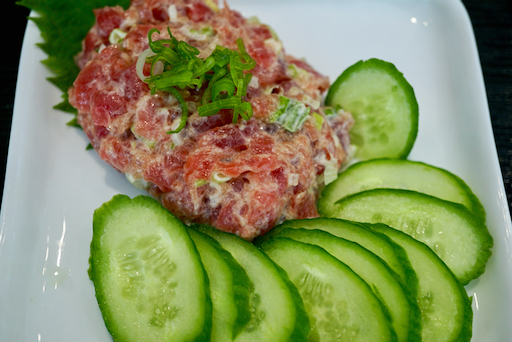Most of the mid-West and Eastern U.S. are having very hot and humid summer days. One of these very hot weekends, I decided to go grocery shopping early in the day to avoid the mid-day heat. At our gourmet grocery store, which opened up just before I arrived, the sushi case had only a few items prepared. One of them was tuna and salmon sashimi. So I got a package intending to serve it for the evening. Both sashimi were rather thickly sliced. Since I happened to have Japanese
nagaimo 長芋, I decided make "
Yamakake" 山かけ from the tuna (left in the picture below) and make a variation of
tuna and avocado cubes using salmon cubes (which would make it salmon and avocado cubes) (right in the picture below).
Since the tuna was yellowfin tuna キハダマグロ, I marinated it after I cut it into small cubes in concentrated Japanese "men-tsuyu" noodle sauce 麺つゆ for several hours in the refrigerator to
make it taste better. I seasoned grated nagaimo or "tororo" とろろ with wasabi dissolved in soy sauce, and placed the tuna on top after draining the excess marinade. I garnished it with strips of nori (I served more nori on the side). This is, of course, is a very common way to serve tuna and nagaimo and we both really like it. We added more nori as we enjoyed this dish.
Since I had limes, after I cut avocado into small cubes, I dressed the cubes with lime juice to prevent discoloration. Cubes of salmon were also marinated in Japanese concentrated noodle sauce in exactly same way as the tuna. I dressed them with finely chopped garlic, dark sesame oil and soy sauce and garnished it with chiffonade of perilla and finely chopped scallion. Since the salmon was much fattier than the tuna, it did not absorb the marinade as much but, over all, this dish really worked. Both the salmon and avocado had a similar oily texture.
As a third dish, I served 4 items on the small plate. Only one that is slightly new is the chicken tenderloin dressed in soy sauce,
yuzu-kosho 柚子胡椒 and finely chopped
edible chrysanthemum 春菊 (blanched, which I happened to have). The chicken tenderloin was removed from
sous vide chicken breast. This was very good. The chrysanthemum gave a slightly bitter taste and went well with the moist tenderloin and yuzu-kosho flavor.
The remaining three items are "
our usual suspects",
Japanese dashi-maki omelet 青海苔入りだし巻きwith aonori,
sugar snap blanched and soaked in salt-seasoned Japanese dashi broth スナップ豌豆の塩びたし, and
simmered taro 里芋の煮付け.
This evening, we tried a new sake (although we had it before in Japan). It is Tengumai but not "daiginjo". This is
Yamahai Junmai 山廃純米天狗舞. The label has a formal name of this old way of making sake 山卸廃止酛仕込(やまおろしはいしもとしこみ). Compared to our new house sake Tengumai daiginjo 天狗舞大吟醸, this is a quite different sake. I think we had this for the first time
when we visited Kanazawa 4 years ago. This sake is savory/rich and dry and has earthy/mushroomy background flavor. Some sake expert suggested that this sake should not be served refrigerator cold but at room temperature and suggested the taste will change as it warms up. I took this bottle out a few hours prior to tasting for that reason. It has a nice golden hue (as opposed to clear as in daiginjo). In general, we prefer clean, fruity and dry sake (daiginjo profile), but we liked this sake. It has much more characters and is not too yeasty like other jumai sake can be. We got this sake from a new sake-specialized internet merchant called "
Tippsy sake". I will post more about this place in more details in the near future.


















































